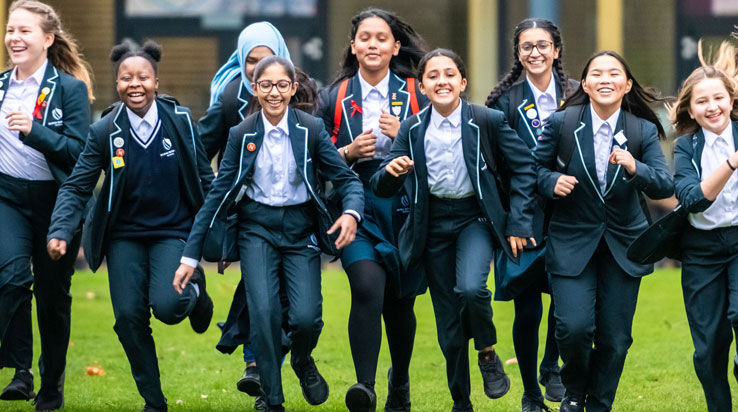
The Background
Sarah Bonnell School is an 11-16 all girls secondary comprehensive school in Newham, East London. With 1,330 students, it attracts girls from a wide catchment area covering all ethnicities, religions and cultures. Newham is one of the more deprived boroughs in the UK, with around forty percent of its students eligible for free school meals. That said, the school has a vibrant mix of students, with many from more affluent backgrounds.
Importantly, the school is based upon a very clear ethos and set of values – “Be Proud. Aim High. Work Hard. Be Kind. No Excuses” – and all students get the opportunity to learn and achieve in an environment where they feel safe, valued and encouraged to try new things without a fear of failure. The school focuses on ensuring their students can get the best qualifications possible and to develop skills, attitudes and behaviours that prepare them to make a positive contribution to society. Over 99.5% of students who leave at 16 go on to college, including the likes of Cheltenham Ladies' College, and in 2020 six alumni secured places at Cambridge University.
Whilst the school can date its roots back to 1769, the current facilities are exceptional with well resourced classrooms that motivate and support students and staff – not least with technology – working with RM (as their IT partner) for many years.
A technology-enabled school
In line with the school’s commitment to staying ahead of the game, Sarah Bonnell were early advocates of the role that modern technology could play within an educational setting, making the decision five years ago to invest in the full suite of Google cloud-based products.
“We started with small steps – just a few teachers using Google Classroom in a limited way (through Action Research) – but it grew term-by-term, year-by-year – and now it is firmly embedded across the school”.
Charlotte Paine, Deputy Headteacher
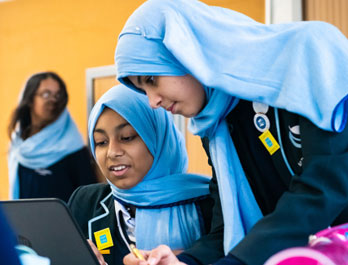
At Sarah Bonnell School they started with small, voluntary “research groups” which encouraged people to sign up to try out this new technology. They were given log-ins and it evolved class-by-class. The reason that adoption grew so readily was simply because teachers – and all staff for that matter – recognised the value it brought – how it engendered better communication, fostered greater collaboration, and led to a much more efficient school environment for all.
“It is also true that this coincided with us running out of server space in our on-site computer room. Added to the fact that all of our file structures were like a rabbit warren, it made us realise that we had to do something different to simplify things and reduce workloads”.
Charlotte Paine, Deputy Headteacher
They started by moving all teaching and learning and assessment to Google. Naturally some teachers were a little reticent at first, concerned that they may lose their work or specific applications that they had invested significant time in over the years. This reflects RM’s own findings from January 2020, where it was suggested that over a third of teachers can be somewhat unconfident with the technology provided by their school.
Critically with this “clean start”, the school wanted to set up a new file and folder structure for the school, and with the assistance of their RM Account Manager they set about a culture change in how work was stored and accessed. Curriculum Leaders and teachers can now see each other’s resources – simply by looking in the relevant file hierarchy – with no need to send emails. This has saved considerable time for all, whilst improving the consistency and efficiency for teachers.
“Google Classroom has resulted in us changing decades-old working practices. We have reduced the amount of emails we need to send, and during the partial school closure we’ve easily adapted to hold meetings via Google Meet”.
Charlotte Paine, Deputy Headteacher
With Google adopted widely for resources and meetings, the next step was to migrate the school’s email and calendar system away from Microsoft Outlook. This was communicated at the end of 2018 for a summer 2019 implementation, giving all staff plenty of notice. The school were reliant on RM to plan and implement this move and were delighted when staff came into school at the start of term in September 2019, logged into Gmail and all of their old emails were safely there as they had left them at the end of the previous term (just in a different application).
Making it work
For Sarah Bonnell School, everything was carefully planned, and they worked with a technology partner who had done this many times before with other schools.
"Sarah Bonnell School has an innovative and collaborative approach to developing teaching and learning. The use of G-Suite increased our capacity to collaborate, create and communicate in a way that engages students and staff".
Rae Potter, Headteacher
Critically they did it step-by-step – taking small cohorts at a time – building advocates and champions internally, as they went.
They also focused heavily on communication. They created their own “Google Top Tips” each week, sharing best practice across the school, with hints and ideas of how to use the software in a practical way. This was backed by plenty of training – aimed at different levels of ability – some led by RM, other by advocates from across the school.
“Now almost everything is done on Google Classroom – I haven’t seen anyone create a presentation in PowerPoint in months”.
Charlotte Paine, Deputy Headteacher
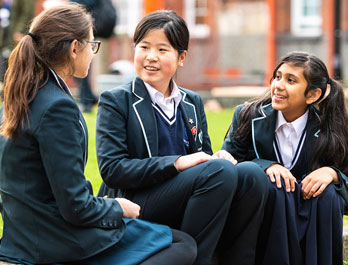
The school also took the decision to invest in the right hardware and devices for their students and staff. From the start of the 2018/19 academic year, they have had 10 Chromebooks in every class, with all students set up as members of both a cohort classroom for their year and a form classroom on the system.
“When lockdown came we were prepared – we had already been doing what lockdown forced all schools to start doing, for well over a year”.
Charlotte Paine, Deputy Headteacher
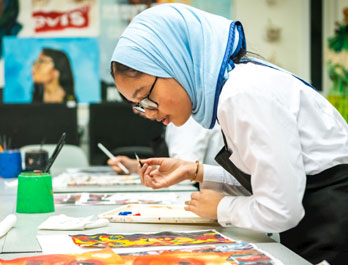
Lockdown and remote learning
For Sarah Bonnell School, their hard work over the previous couple of years really paid off – they had the technology platform in place, and staff and pupils had not only been trained how to operate it, but they were accustomed in using it too.
“I think I would call the move to remote teaching… ‘a walk in the park with a few muddy puddles’!”.
Charlotte Paine, Deputy Headteacher
That said, there were still challenges, with digital exclusion being the biggest hurdle. Given the socio-demographics of many of their students, not all pupils had access to a device at home on which to work – even those households where there were devices, it tended to be shared with parents and other siblings – all working and learning from home at the same time. The school quickly issued what Chromebooks they had to those children who needed it the most, but even then, they did not have anything like the number to go round.
During March, April and early May 2020 teachers were setting asynchronous assignments, where students learnt from instruction – primarily via pre-recorded video lessons and directed activities in Google Docs and Slides. From mid-May onwards they switched to livestreaming of lessons.
Like many schools, Sarah Bonnell School were committed to developing live learning with a clear focus on safeguarding students and staff. The way they made this work was via whole cohort/ subject lessons – for example Year 10 History would livestream, and then it would be Year 7 History etc. They ran a rota system, whereby Curriculum leaders would have to book their slot in advance to avoid clashes and support wellbeing.
There were also always two teachers in every lesson – and it proved very successful, with 100+ students attending many lessons.
So pleased were they with their progress that the decision was made in late-2020 to both move to G Suite Enterprise... AND to purchase an individual Chromebook for every student in the school. This was a big decision, but one they felt was essential. They used a leasing deal as a cost-effective way to spread the burden.
“We want Sarah Bonnell School to be a beacon for blended learning in our area, and this was the best way we felt we could get there”.
Charlotte Paine, Deputy Headteacher
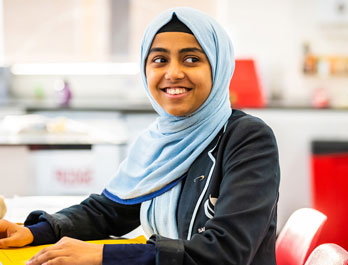
When school re-opens, all students will be expected to bring their Chromebooks to school every day, and whilst they will still be using a pen and exercise book at times, the savings that can be generated by using the technology that already exists, are colossal – from more collaborative working, to simply not needing to spend so much money on photocopying and printing.
“Every student who leaves school will go into a job where they need to use a computer and have at least a reasonable grasp of digital literacy. We are therefore setting them up to be successful in this regard”.
Charlotte Paine, Deputy Headteacher
As of the start of the January Term 2021, the majority of teaching is live, and follows the same standard timetable that students would have followed had they all have been in the physical school. That said, live lessons do not have to be 60 minutes’ long, nor does every lesson need to be live. Teachers are encouraged to use the break-out room capability within Google Classroom within each lesson to encourage students to think for themselves and work with their peers. A typical lesson may involve the teacher setting the scene, directing the pupils to go into online breakout rooms, before returning to present back what they have worked on to the full class.
"Deputy Headteacher Charlotte Paine has modelled best practice with G-Suite from the launch in 2016. Her enthusiasm and expertise has really developed our approach, and the success of our changeover to G-Suite has been fuelled by her great leadership".
Rae Potter, Headteacher
The lessons learnt
- Invest in teacher CPD - confident teachers deliver better Remote and Blended Learning lessons.
- Identify your early adopters - get to know who will lap this up – and who will need more support – and target your resources accordingly. Pair people up, so they can help one another.
- Take your time - whilst the Coronavirus made this hard for many schools, for Sarah Bonnell School they planned ahead and used the time well.
- Think about your technology systems - at Sarah Bonnell School they used the system as a way to encourage people to get used to it – from getting students to log in to give their consent to live streaming, to asking teachers to pre-book their live streamed lessons – all were all done on Google Forms within the system.
- Communication - take people with you – set out the vision, break it into steps, and keep people advised of where you are on the journey.
- Take a broader view of what this truly entails - like many schools, Sarah Bonnell School realised that putting a device into everyone’s hands would be essential. This was a big decision – and one they probably did not consider necessary at the outset – but it was one that they soon realised they had to make, if they were to do this properly.
- Lead from the front, but look for help along the way - for Sarah Bonnell School they had an IT partner with them for the journey – someone who had done something similar with many other schools. This proved invaluable when they were faced with choices – but also when an extra pair of hands was necessary, to make this all work.
The Legacy
Schools will re-open, and whilst amazing things can be done remotely, it is not a replacement for a face-to-face lesson. That said, what this has done is put blended learning firmly on the agenda.
“We want Sarah Bonnell School to be the best educator in our community – we want our students to receive the best possible education and to leave us as well equipped as they possibly can for the next stage of their education. We want our school to gain a reputation for instilling a level of digitally literacy in our students that is second to none”.
Charlotte Paine, Deputy Headteacher
Download a PDF of the case study